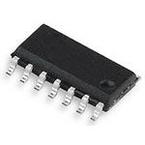●Product Details
●The ADA4177-1 single-channel, ADA4177-2 dual-channel, and ADA4177-4 quad-channel amplifiers feature low offset voltage (2 μV typical) and drift (1 μV/°C maximum), low input bias current, low noise, and low current consumption (500 μA typical). Outputs are stable with capacitive loads of more than 1000 pF with no external compensation.
●The inputs of the ADA4177-1/ADA4177-2/ADA4177-4 feature outstanding precision amplifier robustness, providing input protection against signal excursions 32 V beyond either supply, as well as 70 dB of rejection for electromagnetic interference (EMI) at 1000 MHz.
●Applications for these amplifiers include sensor signal conditioning (such as thermocouples, resistor thermal detectors (RTDs), and strain gages), process control front-end amplifiers, and precision diode power measurement in optical and wireless transmission systems.
●The ADA4177-1/ADA4177-2/ADA4177-4 operate over the −40°C to +125°C industrial temperature range. The ADA4177-1/ADA4177-2 are available in an 8-lead SOIC package and an 8-lead MSOP package. The ADA4177-4 is available in a 14-lead TSSOP and a 14-lead SOIC package.
●Applications
● Wireless base station control circuits
● Optical network control circuits
● Instrumentation
● Sensors and controls
● Thermocouples, RTDs, strain gages, shunt current measurements
●### Features and Benefits
● Low offset voltage: 60 μV maximum at 25°C (8-lead and 14-lead SOIC)
● Low offset voltage drift: 1 μV/°C maximum (8-lead and 14-lead SOIC)
● Low input bias current: 1 nA maximum at 25°C
● Low voltage noise density: 8 nV/√Hz typical at 1 kHz
● Large signal voltage gain (AVO): 100 dB minimum over full supply voltage and operating temperature
● Input overvoltage protection to 32 V above and below the supply voltage rail
● Integrated EMI filter
● 70 dB typical rejection at 1000 MHz
● 90 dB typical rejection at 2400 MHz
● Rail-to-rail output swing
● Low supply current: 500 μA typical per amplifier
● Wide bandwidth
● Gain bandwidth product (AV = 100): 3.5 MHz typical
● Unity-gain crossover (AV = 1): 3.5 MHz typical
● −3 dB bandwidth (AV = 1): 6 MHz typical
● Dual-supply operation
● Specified at ±5 V to ±15 V, operates over ±2.5 V to ±18 V
● Unity-gain stable
● No phase reversal
● Long-term offset voltage drift (10,000 hours): 2 μV typical
● Temperature hysteresis: 2 μV typical

 Part 3D Model
Part 3D Model
